The Historic Mount Washington Hotel at Bretton Woods, NH
Explore the historic highlights of the iconic Mount Washington Hotel at Bretton Woods, NH – one of New England’s few remaining grand hotels.
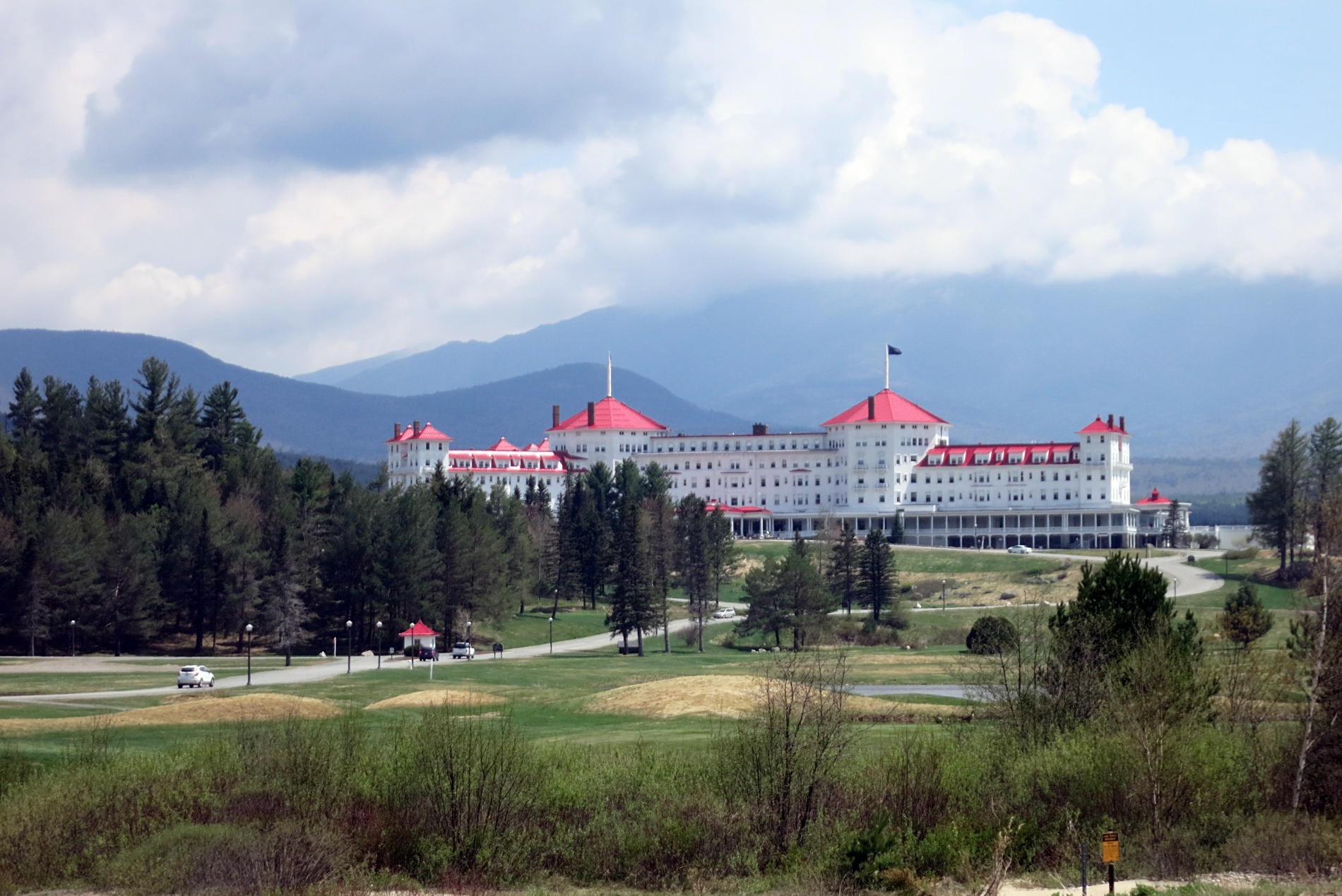
Approaching the historic Omni Mount Washington Resort at Bretton Woods, NH.
Photo Credit : Aimee SeaveyAs one of the few remaining grand hotels in New England, the Omni Mount Washington Hotel at Bretton Woods, NH, is a true White Mountains treasure. To visit is to time-travel back to the railroad-era of the early 1900s, when wealthy city-dwellers journeyed north to spend their entire summers in the fresh mountain air, but beyond history, the hotel also prides itself on more than a century of hospitality in one of the most beautiful settings in the country.
The iconic White Mountains hotel is the flagship property of the Omni Mount Washington Resort, and was originally built by wealthy New Hampshire native Joseph Stickney. Designed by architect Charles Alling Gifford, the project began in 1900 and was completed in July, 1902. Its style is Spanish Renaissance Revival (hence the red roof to mimic the tiled roofs of Spain), and construction included more than 2,000 doors, 900 kegs of nails, 11 miles of plumbing, and more than 1,200 windows.
It was an instant summer success.
Guests arrived by train from Boston and Portland and were brought to the hotel via horse and carriage, and it’s easy to imagine their view upon arrival — motorists experience the same “wow” moment today heading up the hotel’s long drive.
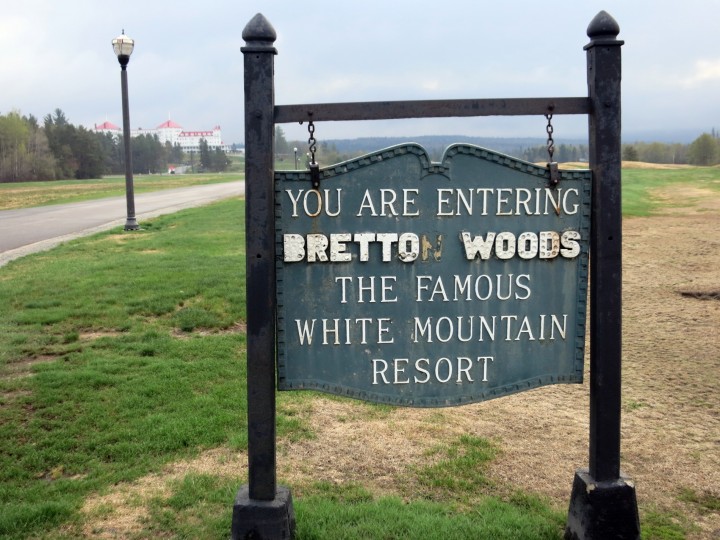
Photo Credit : AImee Seavey
The name Bretton Woods has always confused me…is it another name for the hotel? The town it’s in? Where is Bretton Woods? To clarify, Bretton Woods (where the hotel is located) is a village in the town of Carroll, NH. Because the hotel was so often referred to as “The Mount Washington Hotel at Bretton Woods,” the names became synonymous.
Today, the hotel offers not just a place to stay and dine in luxurious comfort, but numerous amenities such as two golf courses, skiing, a spa, tennis, and horseback riding. For many guests, however, the hotel’s history alone is enough of a reason to visit.
Well, that and the mountain views, which are spectacular.
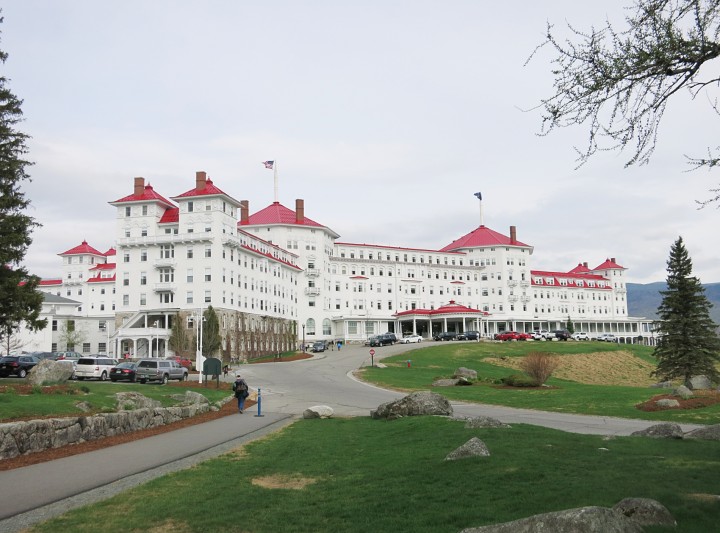
Photo Credit : Aimee Seavey
My visit was in late spring (the reason was a trip up Mount Washington on the Mount Washington Cog Railway), and the weather wasn’t entirely cooperating. The sky was heavy with clouds and fog, but sometimes, the sun would wrestle through and bathe the landscape with a few moments of sunshine. I can only imagine how the mountains must look on a clear summer day or snow-covered winter morning…
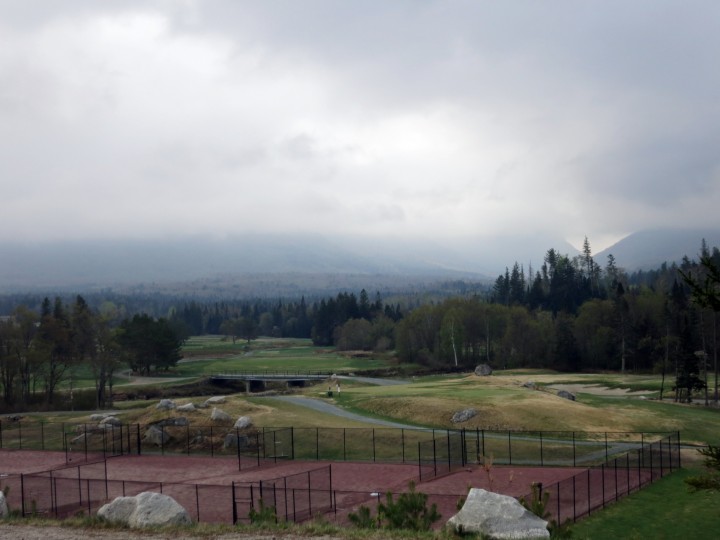
Photo Credit : Aimee Seavey
Inside the Mount Washington Hotel, you’re greeted by the enormous French Renaissance-style Great Hall with large windows on either side to encourage cross-breezes in the days before air conditioning. Originally called the Assembly Hall, the focal point of the room is a giant fieldstone fireplace, but the several crystal chandeliers (added in the 1920s) are also pretty impressive. The room underwent a massive restoration in 2007, and period photographs and postcards were consulted to help re-incorporate original historic details back into the decor. Examples of this are the moose head mounted above the fireplace, and the custom carpeting that depicts local flora and fauna.
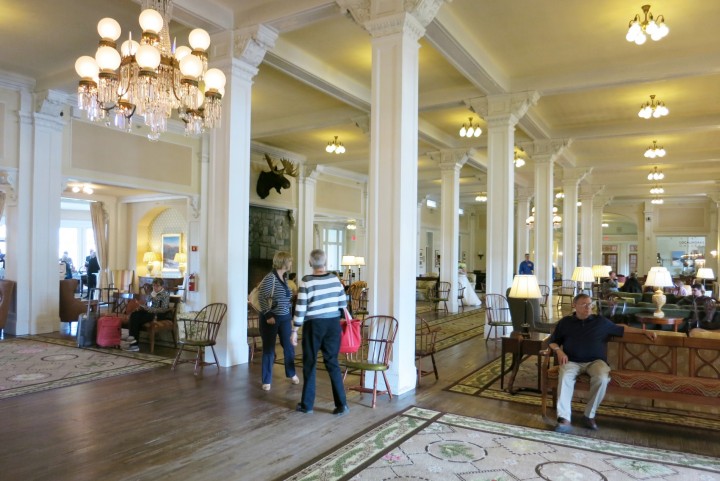
Photo Credit : AImee Seavey
Of special note is the 19th century grandfather clock tucked to the left of the fireplace. Before the hotel was open year-round (starting in 2001), the starting of the clock signaled the beginning of the summer season. On the final day, the last guest would stop the pendulum until the following season began. The clock is one of the few original pieces remaining in the Mount Washington Hotel Great Hall.
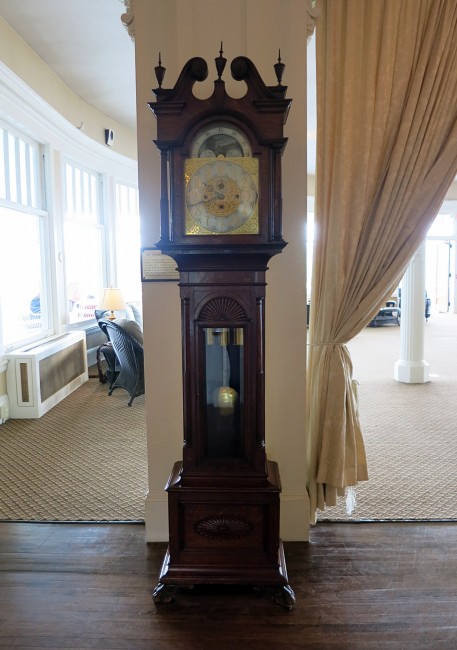
Photo Credit : Aimee Seavey
Beyond the Great Hall (behind the moose) is the Mount Washington Hotel Conservatory. Originally called the Hemicycle, the half-circle shaped sun parlor is made almost entirely of plate glass with stunning views of the Presidential Range. Its domed ceiling, ringed with Tiffany glass, gives the room natural acoustics that make it an ideal spot for concerts, lectures, and poetry readings. The room is also home to an original 1881 Steinway piano, so make sure you don’t set your drink down on it — its value has been estimated in the hundreds of thousands of dollars!
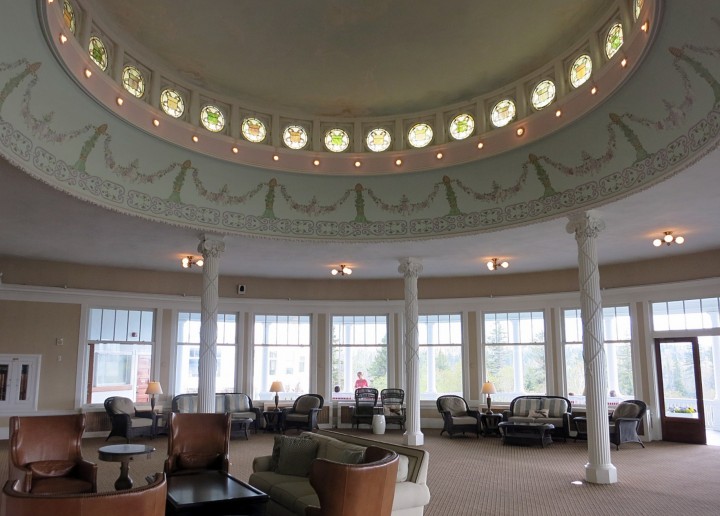
Photo Credit : AImee Seavey
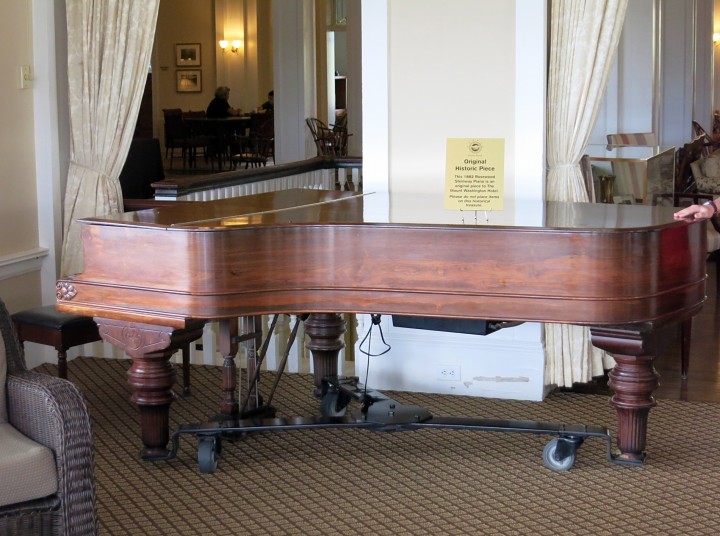
Photo Credit : Aimee Seavey
Beyond the Conservatory is the spectacular covered outdoor Veranda. Spanning 903-feet, it’s the longest in New England. Six laps around the Veranda guaranteed early 20th century guests (and still does today) a healthy mile of exercise when the weather was poor, and between its 122 columns, gorgeous views of the mountains and grounds offered plenty to admire. Of course, you can also choose to sit in one of the hotel’s many comfy wicker offerings to admire the scenery or sip a coffee. Verandas and wicker go together like peanut butter and Fluff here in New England, don’t they?
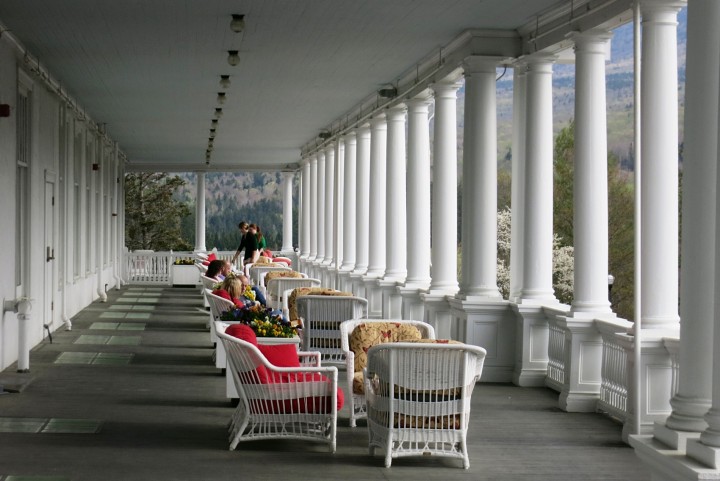
Photo Credit : Aimee Tucker
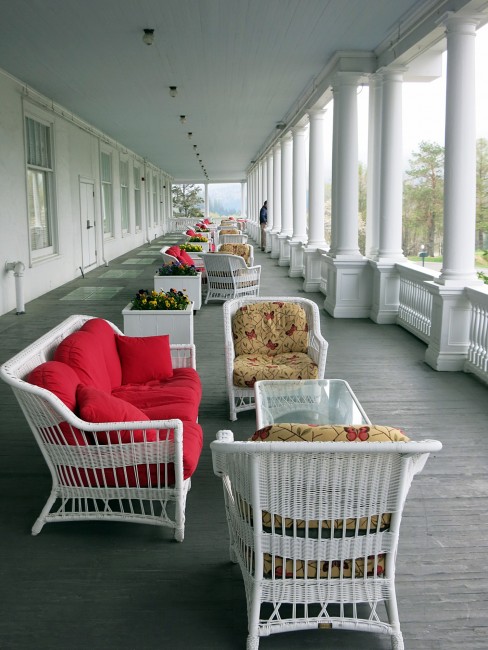
Photo Credit : Aimee Seavey
Jutting off the back right side of the main level of the hotel, the open-air Jewell Terrace (the Conference Center and Spa, built in 2008, is underneath) also affords a lovely view. I didn’t get a chance to enjoy the Mount Washington Hotel Spa, but I hear it offers multiple indulgences, skin care, body treatments, and regular salon services.
There’s that sun trying to beat back the clouds!
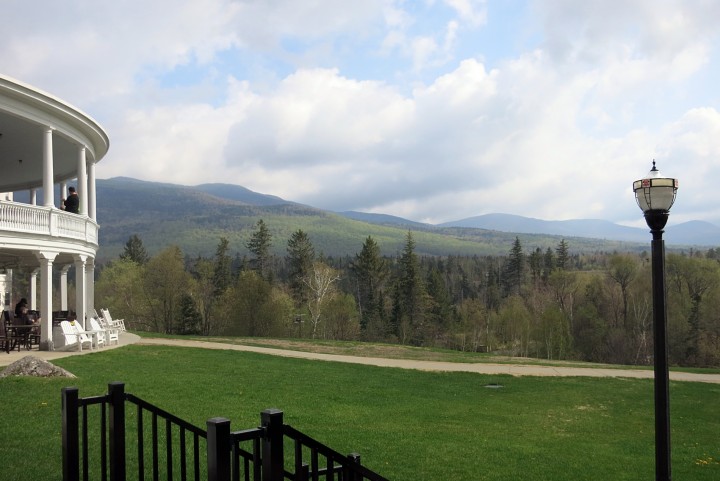
Photo Credit : AImee Seavey
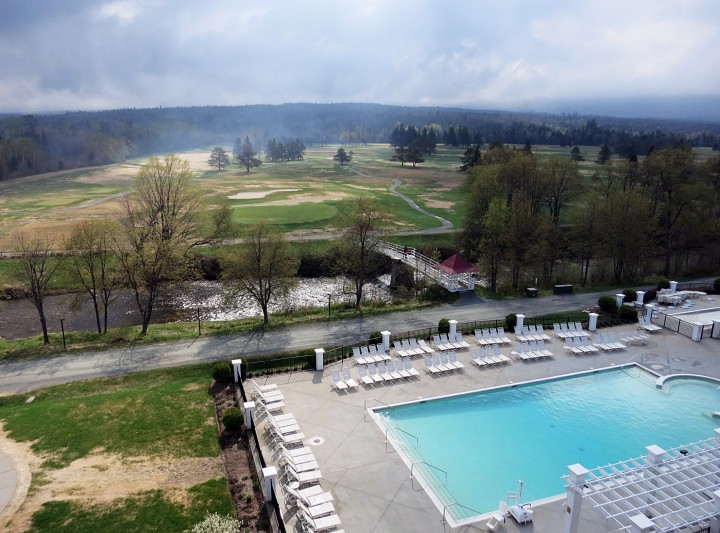
Photo Credit : Aimee Seavey
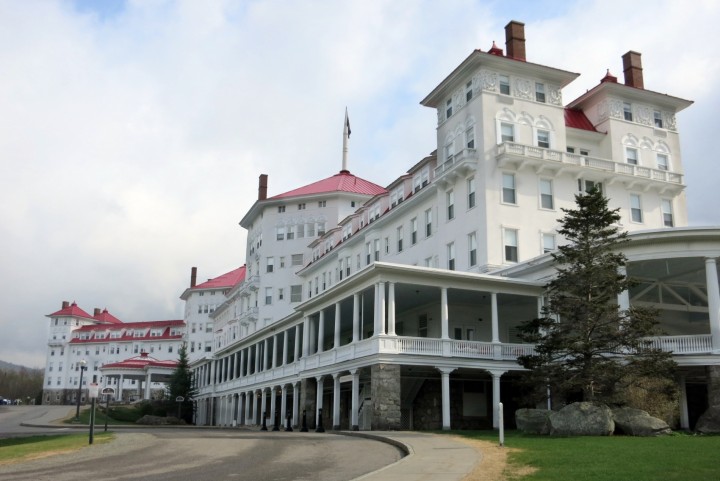
Photo Credit : AImee Seavey
Back inside, to the right of the Main Hall, is one of the Mount Washington Hotel’s most significant rooms — the Gold Room. It represents both the hotel’s rebirth after years of wartime vacancy, and an important event in world history.
Hotel business had waned during the 1930s, with Prohibition and the Great Depression (not to mention the nimble automobile) taking an enormous toll on the hospitality industry. After Carolyn Stickney (the wife of founder Joseph Stickney) died in 1936, her nephew inherited the hotel, but when World War II broke out in 1942, he decided to close. Two years later, a Boston syndicate bought the property for $450,000, and when the government was searching for an ideal location to hold a worldwide conference to deal with the financial aftermath of the war (now known as the Bretton Woods Conference), they chose the Mount Washington because of its secure location and ample room for the 730 delegates from 44 nations that would be attending.
Unfortunately, the Mount Washington Hotel had been vacant for several years and was badly in need of repairs. Roofs had collapsed under heavy snow and wallpaper was peeling off the walls. Undaunted, the government sent in 150 workers armed with new furniture and 50 cans each of white paint. With just 2 months until the Conference, they were told that if it didn’t move, to paint it white…and (gulp) that’s just what they did. The paint made everything look clean and new, but the workers weren’t concerned with historic preservation, so they painted right over the mahogany doors, brass fixtures in the Great Hall, and even some of the Tiffany windows.
The Conference took place over 21 days in July, 1944 (the owners were paid $300,000 for the loss of business and a daily room charge of $18 per person) and concluded with the signing of the final Articles of Agreement for the International Monetary Conference. This (among other things) established the World Bank, the International Monetary Fund, the gold standard, and U.S. currency as king — all of which were intended to restore worldwide financial stability and prosperity after the devastation of World War II.
While meetings took place all over the crowded hotel, the Gold Room, with its 14 chairs for the 14 power nations that took part in the formal signing, endures as a tribute. The table (originally Carolyn Stickney’s own private dining table) is the same one on which the documents were signed, and the light fixture above is a gasolier, a kind of electric lamp that also included gas in case the power should go out during the Conference.
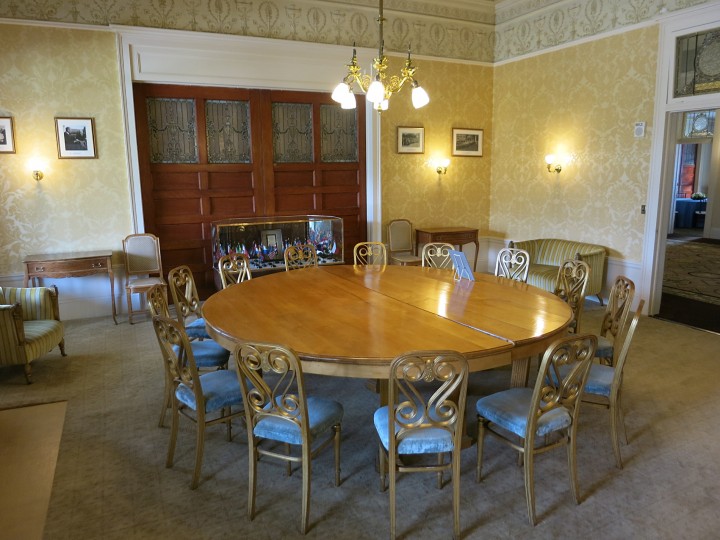
Photo Credit : Aimee Seavey
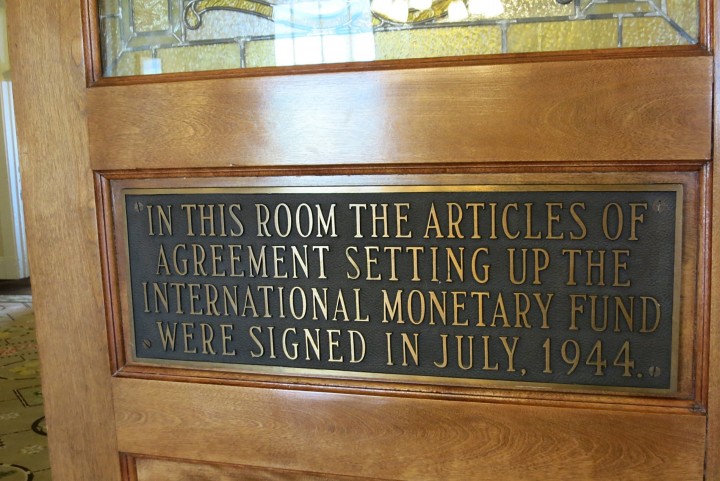
Photo Credit : AImee Seavey
Beyond the Gold Room is the Omni Mount Washington Hotel Grand Ballroom. Today, it looks very much like any other Grand Ballroom in a fine hotel, playing frequent host to weddings, meetings, and other large social occasions. Look closely, though, and you’ll see the original Tiffany glass between the columns. How many hotel ballrooms can say they have that!?
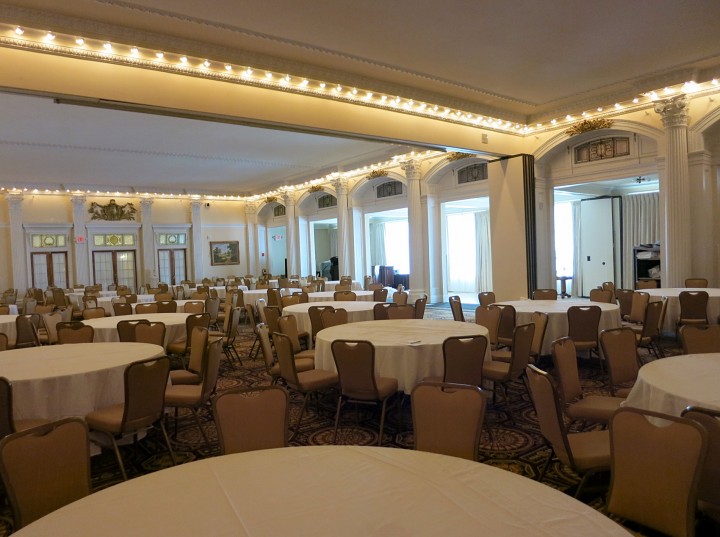
Photo Credit : Aimee Seavey
And on the other side of the Great Hall (let’s pause for a moment and say hello again to the Great Hall moose as we traipse the long length of it)…
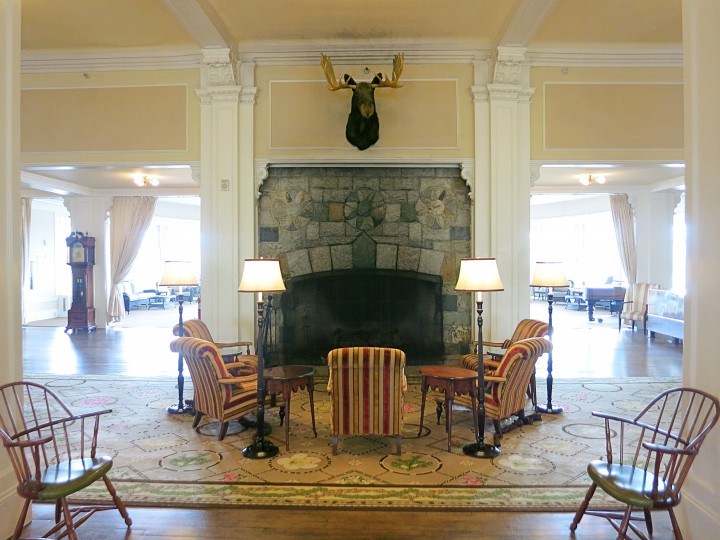
Photo Credit : Aimee Seavey
…you’ll find the Grand Staircase leading up to the guest rooms, across from the reception area. The stairs are wide and shallow, allowing for the ladies of the day to easily travel up and down without tripping over their skirts.
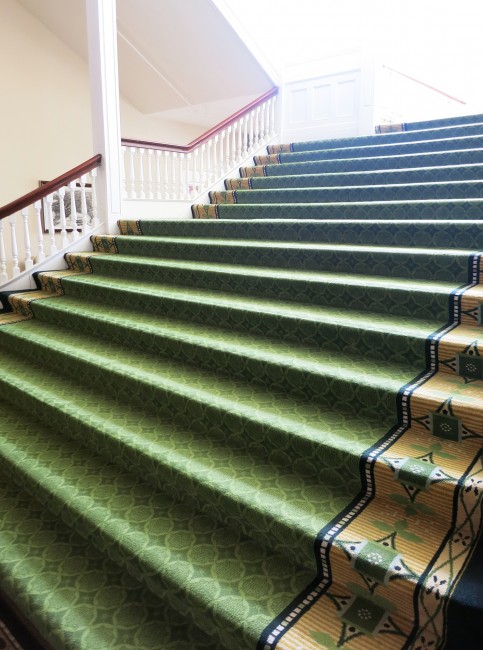
Photo Credit : Aimee Seavey
In fact, it’s said that Carolyn Stickney used to watch the nightly procession from behind a curtain on the balcony near the Front Desk. If she saw a lady with a finer dress than the one she intended to wear to dinner, she would change before making her own entrance.
This endearing critical tradition is memorialized in a painting at the hotel in the spot where the balcony once was.

Photo Credit : Aimee Seavey
To the left of the stairs are the Princess Room and Main Dining Room. The Princess Room was Carolyn Stickney’s private dining room. Today it’s one of the few spots in the hotel that escaped the great white paint incident of 1944, making its gold-leaf accents a lucky remainder from the hotel’s original decor.
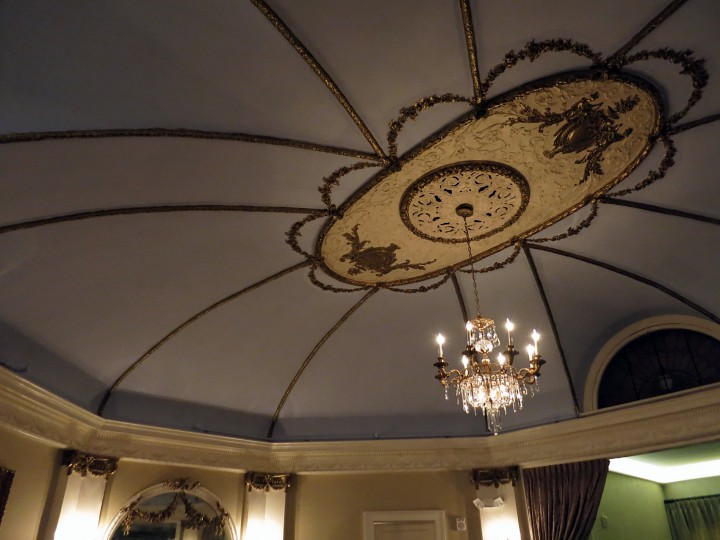
Photo Credit : Aimee Seavey
Large and sunny in comparison, the Main Dining Room at the hotel was octagonal in shape so that no guest might feel the shame of being placed in the corner, and afforded beautiful views of the mountains. An extension of the dining room, called the Sun Dining Room, was added in 1906.
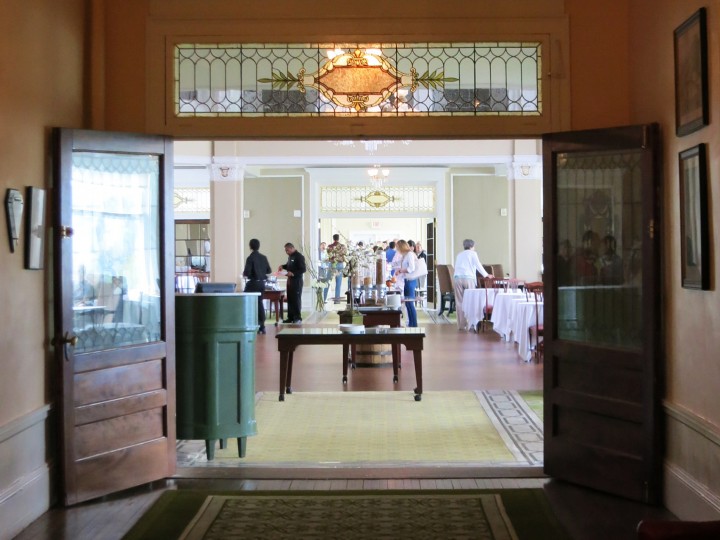
Photo Credit : Aimee Seavey
Along with an orchestra, the Bretton Woods Boy Singers (which included my father and uncles in the 1960s) would perform in balconies on either side of the room, and recent restorations have revealed the room’s original Tiffany windows and brass fixtures under multiple layers of paint.
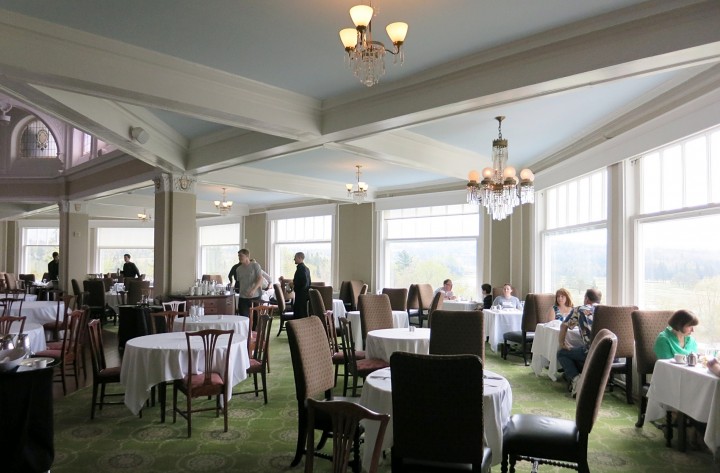
Photo Credit : AImee Seavey
Heading down to the hotel’s lower-level (or “Patio Level”), sun-filled rooms give way to shadowy brick, although the flora and fauna custom carpet continues. Here, a blend of old and new have created an entirely unique space.
What was once a bowling alley is now a conference room, a ladies lounge a gift shop, and the hotel’s billiards room a casual restaurant named after the hotel’s founder.
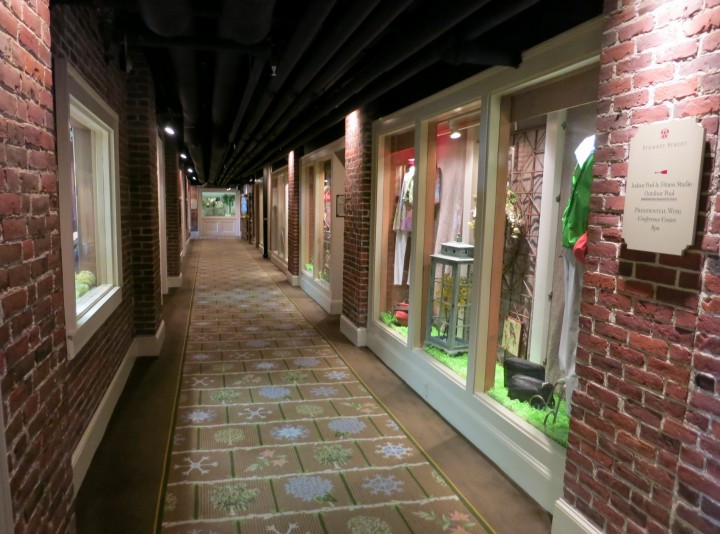
Photo Credit : Aimee Seavey
There’s also a cafe, arcade and candy shop for kids, and even a Post Office — at one time, the only hotel Post Office with its own zip code (03575).
Of special note is a bar known as Cave. Originally the hotel’s squash courts, the space was later converted into a bar and grill, and was a speakeasy during Prohibition, with guests drinking spirits out of teacups.
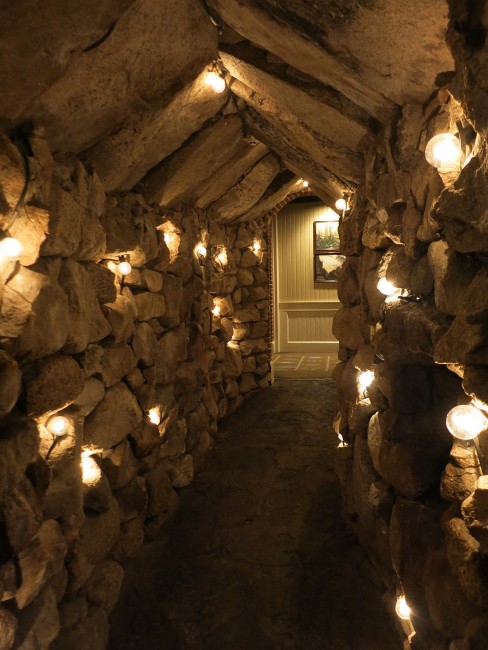
Photo Credit : Aimee Seavey
Today, it remains a popular watering hole, sometimes with live music.

Photo Credit : AImee Seavey
There’s also the hotel’s indoor pool — one of the first of its kind in the country. When Carolyn Stickney was in the mood for a swim, all of the other guests would have to get out and leave the room until she was finished.
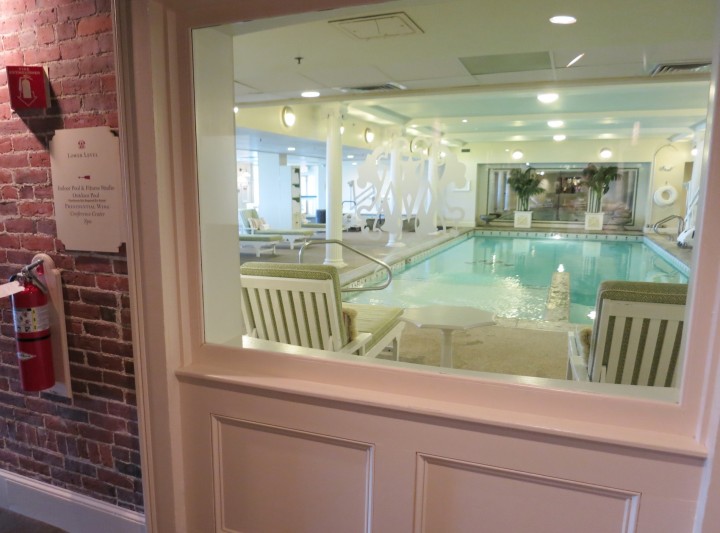
Photo Credit : Aimee Seavey
So now we’ve seen the hotel’s Main Level, Patio Level, and natural surroundings — but what about one of the most important parts of a hotel, the guest rooms?
I can only show a photo of my own for the evening, a spacious room with an odd layout. Here, you can see the large main bedroom. Behind me is a bathroom that connects to a small, narrow sitting area (it was exactly the size of my one-person college dorm room), and the door to the hallway is in the sitting area — not the bedroom (although the bedroom has a door to the hallway, too.). Why the odd setup?
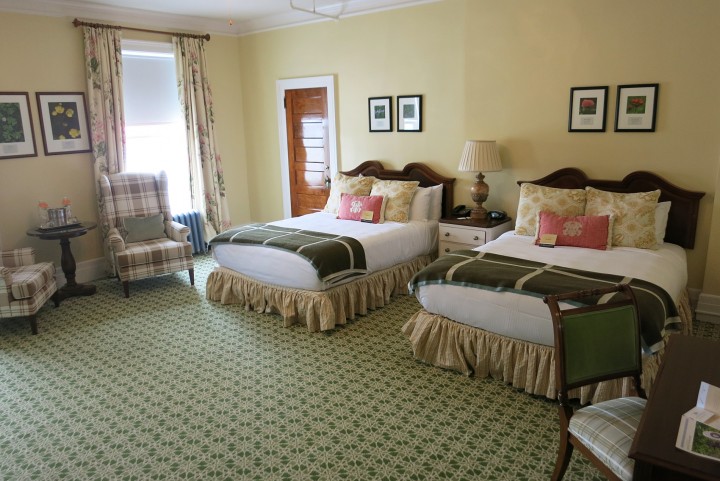
Photo Credit : AImee Seavey
When the Mount Washington Hotel was built, families would come for the entire summer, bringing not just mother, sometimes father, and children, but an entire staff. Their quarters were designed like connecting suites, with both large and small rooms to accommodate each guest. And since the hotel has been updated and renovated, but not rebuilt, they’ve had to fashion individual guest rooms out of the original multiple connecting suites. This leads to rooms that are curiously laid out, but wonderfully fun to navigate and imagine the previous inhabitants.
They’re also lovely, comfortable, and full of charm.
So there’s the lot of it, for this visit at least. With more than a century of history, hospitality, and tranquility to its name, it’s easy to see why the Mount Washington Hotel (declared a National Historic Landmark in 1986, and now a member of the Omni Hotels & Resorts since 2009) continues to attract visitors, and not just endure, but grow.
Before saying goodbye, I took one final stroll around the Veranda, admired the natural beauty of the White Mountains National Forest, and promised myself I’d be back soon.

Photo Credit : Aimee Seavey
Have you ever visited or stayed at the Mount Washington Hotel or another of New England’s grand hotels? Which is your favorite?
Omni Mount Washington Resort. 310 Mount Washington Hotel Road, Bretton Woods, NH. 603-278-1000; omnihotels.com.
This post was first published in 2015 and has been updated.
SEE MORE:
Tour the Omni Mount Washington Resort (video)
Bretton Woods | Ski Trail Favorites
Best of the New Hampshire White Mountains
Aimee Tucker
Aimee Tucker is Yankee Magazine’s Home Editor and the Senior Digital Editor of NewEngland.com. A lifelong New Englander and Yankee contributor since 2010, Aimee has written columns devoted to history, foliage, retro food, and architecture, and regularly shares her experiences in New England travel, home, and gardening. Her most memorable Yankee experiences to date include meeting Stephen King, singing along to a James Taylor Fourth of July concert at Tanglewood, and taking to the skies in the Hood blimp for an open-air tour of the Massachusetts coastline.
More by Aimee Tucker

